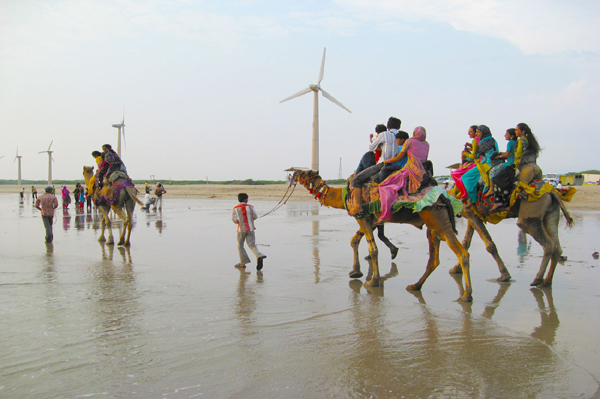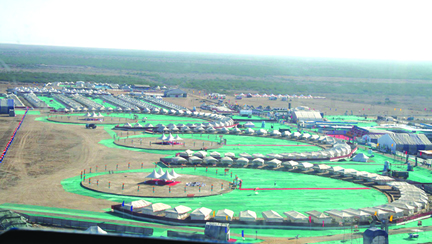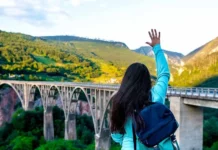Unsurpassed in beauty, exuberance & color
 Breathtaking vistas, intriguing history, an abundance of tradition, color, and enchantment – this is Kutch, the perfect host for anyone’s next vacation. Remote and strange could best sum up the Kutch experience. And yet, the region remains unsurpassed in terms of beauty, exuberance, and color that no one with a taste for adventure, excitement, and the exotic would like to miss. Lying in the westernmost part of Gujarat, Kutch becomes an island where during the monsoon months the Gulf of Kutch is separated from the Kathiawar Peninsula. To the north also, Kutch gets separated from the Sindh region of Pakistan by the great Rann of Kutch.
Breathtaking vistas, intriguing history, an abundance of tradition, color, and enchantment – this is Kutch, the perfect host for anyone’s next vacation. Remote and strange could best sum up the Kutch experience. And yet, the region remains unsurpassed in terms of beauty, exuberance, and color that no one with a taste for adventure, excitement, and the exotic would like to miss. Lying in the westernmost part of Gujarat, Kutch becomes an island where during the monsoon months the Gulf of Kutch is separated from the Kathiawar Peninsula. To the north also, Kutch gets separated from the Sindh region of Pakistan by the great Rann of Kutch.
The Kutch area is the home of the last remaining population of khur (Asiatic wild ass) in India. There is also a large bird population, particularly of the large flamingos. Both are protected in the 5,000 km Little Rann Sanctuary, which is approached from Dhangadhra; one has to get permission to enter from the sanctuary superintendent’s office in Dhangadhra.
Best time to visit: Being in the arid area of the country, the climate of the Kutch region is extreme: hot during summer and very cold during winter. Summer is rather severe in the entire state of Gujarat. The amount of rainfall is very little and during the rainy season also the area experiences scanty rain. As winters are comparatively bearable and pleasant, the best time to visit this place would be between November and March. Woolens in sufficient numbers are required during the winter months.
History: Founded only recently in 1548, Bhuj is the central town of Kutch. It was set up when Khengarij I of the Rao dynasty of Kutch shifted his capital from the town of Anjar. Due to its proximity to the sea, which facilitated trade, a lot of cultural interaction took place. Even today, the city of Bhuj presents exciting amalgams of the Orient and the Occident, especially in terms of architecture.
Tourist attractions
The picturesque town of Bhuj has a dramatic setting. Located rather low, it is basically an amphitheatre of hills dominated by the Bhuja Hill that rises to a height of 160 m at one end and is in itself a landmark – being flat on top and surmounted by the fortifications of a hill fort. This strategically located fort served the purpose of sighting enemies and alerting defense. An old wall surrounds the city (also made for security reasons). Interestingly, till recently, the city gates were locked each night from dusk to dawn but now entry into Bhuj can be made at any time of the day as the city is always welcoming.
Then there is the quaint Kutch Museum – the oldest in Gujarat. Regarded as one of the best. This museum has an excellent collection. Founded in 1877 by Sir James Ferguson, who was Governor of Bombay under the British Raj, the museum was earlier referred to as the Ferguson Museum.
This unassuming edifice has been divided into two floors containing a picture gallery, an anthropological section, an archeological section, textiles, weapons, musical instruments, a shipping section, and even stuffed animals. The piece de resistance here is the celestial elephant Airawat made of wood. Yet another that warrants attention is the cannon that was presented by Tipu Sultan to the Kutch rulers in exchange for some horses of the region that are known for their swiftness and vitality.
Walking through the maze of winding streets takes visitors to the exquisite Aaina Mahal (palace of mirrors). It was the palace of the erstwhile Maharao of Bhuj, but it has now been converted into a museum. Members of the royal family now live in the Old Palace behind it. Presenting a fascinating amalgam of Indian and Dutch styles of architecture, the Aaina Mahal is definitely worth a visit.
The walls of the main hall are covered with mirrors all around, and except for a narrow strip used for walking, the entire space has been beautifully utilized to form a pleasure pool. Fountains are placed in such a manner that they cast their spray in an intricate variety of patterns. Lit by candles and cooled by the gentle ripples of the pool waters, the Maharao and his retinue sat in the space left in the middle as they sought refuge from the glaring heat of the sun.
It was here that Maharao Shri Lakhpatji often sat to compose poetry and watch musical performances. It was under his patronage that the classical arts flourished. The Aaina Mahal also contains exquisite specimens of intricately cared embroidered panels, lithographs, cutglass, 18th-century paintings and clocks, one even dating back to 1849.
 Facing the Aaina Mahal is the City Palace, the lovely architectural gem of Bhuj designed by a Scottish architect called McClelland. While most of it is closed to visitors, the Durbar Hall remains open. A look around reveals a marked European influence with sculptures and carvings typifying the amalgam arts of Bhuj. The most outstanding and marvelous monuments that would delight all visitors to Bhuj are the royal cenotaphs popularly known as chhatris.
Facing the Aaina Mahal is the City Palace, the lovely architectural gem of Bhuj designed by a Scottish architect called McClelland. While most of it is closed to visitors, the Durbar Hall remains open. A look around reveals a marked European influence with sculptures and carvings typifying the amalgam arts of Bhuj. The most outstanding and marvelous monuments that would delight all visitors to Bhuj are the royal cenotaphs popularly known as chhatris.
Special handicrafts
The villages of the Kutch region specialize in a different form of handicraft, and it would be easy to spend a week visiting some of them using Bhuj as a base. Due to their proximity to the Pakistan border, you will require a permit signed by the Bhuj District Collector to visit the villages north of Bhuj. The map issued by the Bhuj tourist office lists the villages one can visit with or without permission.
Some of the more important villages (and the crafts they specialize in) include Bhujjodi (wool and cotton weaving), Padhar and Dhaneti (Ahir embroidery), Dhamanka (block printing), Lilpur (embroidery) and Anjar (nutcrackers, block printing, and tie and dye).
Near the Dattatreya Temple at Kaladoongar (the black hills), which overlooks the spectacular Rann, one can spot some rare species of white foxes that would delight wildlife lovers. These beautiful, frisky animals staying in the wild respond to the call of the temple priest as he beats a steel plate yelling “langa” to suggest that food has been laid out for them.
Although jeeps and cars can easily go up the steep path to the Devi Temple that is perched right up on the Black Hills, climbing gives an opportunity to admire the scenery around. Also, remember that the temple priest’s hospitality is not for the foxes alone but extends to all visitors as he generously distributes pauwa from the temple kitchens.
Lying close to the beach near Bhuj is the Vijay Vilas Palace that was the summer retreat of the Maharaos of Kutch. Crowned by elegant chhatris (cenotaphs), this sandstone-hued edifice was built in the 1930s.
A flight of steps leads up to the grandest of chhatris that stands on a lofty platform. This is the place where fifteen veeranganas (brave women) who belonged to the court of Maharao Lakhpat committed jauhar (self-immolation) after his death. What is surprising to learn is that none of these women were his wedded queens but only his loyal companions. Adept in music and dancing, these veeranganas entertained royal guests and, when required, even served as spies in the courts of political rivals.
Fairs & festivals:
From the first day of the Kutch Fair, the air is charged with festivity as Bhuj reverberates with a thousand colors. Enthralling opportunities are offered to visit the surrounding areas – even to the interiors of Kutch to give visitors a glimpse of the simple lifestyle of the tribals there. The artistic creativity of the people residing in the area called Bhuga can be seen at every corner – how they use vegetable colors to create wonderful designs on the walls, and further decorate them with mirrors and beads.
All attention is, however, focused on the fair grounds at Bhuj that resound with festivity and music. Besides all this are the plethoras of cultural programs organized by the tourism department that carry on late into the night. It is really an opportunity to learn of the variety of dances that Gujarat has to offer – ranging from brisk acrobatic movements to a single fast beat ending in formation of different kinds of pyramids.
On the last day of the fair that coincides with the Shivaratri festival, a grand fair is also organized at Dhang where local people, dressed in colorful, traditional costumes, congregate to pay homage at the shrine to Mekan Dada, which incidentally, or rather curiously, has a Shivalinga on its premises. A little away, in an open field, much excitement prevails where competitions are organized-camel, horse, and bullock races and the much-loved kushti (wrestling) bouts.
How to reach: There are two options to get into Kutch, the headquarters of the region-either by road or by air from Ahmedabad. But to enjoy the grand spectacle of territories wild and primordial, the former option would be better for the visitors.
Air – Bhuj, the main town of Kutch has daily flights from Bombay, which take about 40 minutes to reach.
Rail – Kutch Express is available from Bombay via Ahmedabad up to Gandhinagar. From here, one can reach this destination by road.
Road – State transport buses are available from Ahmedabad.






